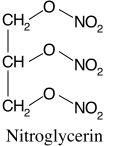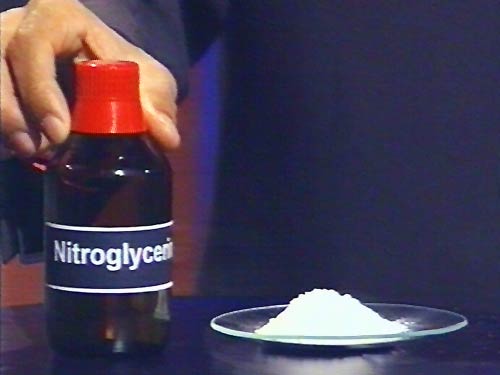Generic Medicines
Taj Pharma is the largest generic pharmaceutical company in India. We hold top positions in different established markets worldwide generics markets..
Nitroglycerin CAS 55-63-0
IUPAC Name: 1,3-dinitrooxypropan-2-yl nitrate | CAS Registry Number: 55-63-0
Synonyms: nitroglycerin, Nitrostat, Trinitroglycerin, Glyceryl trinitrate, Nitroglycerine, Nitroglycerol, Nitroderm, Nitroglyn, Nitrospan, Minitran, Nitro-dur, Nitrol, Trinitroglycerol, Perlinganit, Epinitril, Gilustenon, Millisrol, Nitrocine, Nitromint, Nitroplast
Molecular Formula: |
C3H5N3O9 |
Molecular Weight: |
227.086500 [g/mol] |
H-Bond Donor: |
0 |
H-Bond Acceptor: |
9 |
Exposure Limits
NIOSH REL: ST 0.1 mg/m3 [skin]
OSHA PEL†: C 0.2 ppm (2 mg/m3) [skin]
InChIKey: SNIOPGDIGTZGOP-UHFFFAOYSA-N
Nitroglycerin Property
Fp : 12°C
CAS Data Base Reference: 55-63-0(CAS DataBase Reference)
NIST Chemistry Reference: 1,2,3-Propanetriol, trinitrate(55-63-0)
EPA Substance Registry System: 1,2,3-Propanetriol, trinitrate(55-63-0)
Safety
Hazard Codes : E,T+,N
Risk Statements : 11-51/53-33-26/27/28-3
Safety Statements : 7-16-61-45-36/37-35-33
RIDADR : 1993
Hazard Class : 1.1A
Packing Group : I
Hazardous Substances Data: 55-63-0(Hazardous Substances Data)
Nitroglycerin Chemical Properties, Usage, Production
General Description:
Colorless to pale-yellow, viscous liquid or solid (below 56°F). (Note: An explosive ingredient in dynamite (20-40%) with ethylene glycol dinitrate (80-60%).).
Air & Water Reactions
Highly flammable.
Reactivity Profile
Nitroalkanes,
Packing: N/A
Explosive Liquid
Incompatibilities & Reactivities :
Heat, ozone, shock, acids [Note: An OSHA Class A Explosive (1910.109).]
Reactivity Profile: Nitroalkanes, such as NITROGLYCERIN, range from slight to strong oxidizing agents. If mixed with reducing agents, including hydrides, sulfides and nitrides, they may begin a vigorous reaction that culminates in a detonation. Nitroalkanes are milder oxidizing agents, but still react violently with reducing agents at higher temperature and pressures. Nitroalkanes react with inorganic bases to form explosive salts. The presence of metal oxides increases the thermal sensitivity of nitroalkanes. Nitroalkanes with more than one nitro group are generally explosive. Nitroalkanes are insoluble in water. Flammable/combustible material. May be ignited by heat, sparks or flames. Nitroglycerin is incompatible with the following: Heat, ozone, shock, acids. Note: An OSHA Class A Explosive (1910.109). .
Health Hazard: Inhalation or contact with material may irritate or burn skin and eyes. Fire may produce irritating, corrosive and/or toxic gases. Vapors may cause dizziness or suffocation. Runoff from fire control may cause pollution.
Fire Hazard
HIGHLY FLAMMABLE: Will be easily ignited by heat, sparks or flames. Vapors may form explosive mixtures with air. Vapors may travel to source of ignition and flash back. Most vapors are heavier than air. They will spread along ground and collect in low or confined areas (sewers, basements, tanks). Vapor explosion hazard indoors, outdoors or in sewers. Runoff to sewer may create fire or explosion hazard. Containers may explode when heated. Many liquids are lighter than water.
[Note: An explosive ingredient in dynamite (20-40%) with ethylene glycol dinitrate (80-60%).]
STORAGE: All formulations should be kept at room temperature, 15-30 C (59-86 F). The sublingual tablets are especially susceptible to moisture. They should NOT be kept in bathrooms or kitchens because of the greater moisture in these rooms. Care should be taken to replace the sublingual tablets every six months.
PRESCRIBED FOR: Nitroglycerin is used for the treatment and prevention of angina caused by coronary artery disease. Transdermal nitroglycerin, nitroglycerin ointment and capsules do not act rapidly enough to be used for acute angina attacks. Nitroglycerin also is used intravenously to treat congestive heart failure associated with myocardial infarction (heart attack) and high blood pressure during surgery.
SIDE EFFECTS: A persistent, throbbing headache commonly occurs with nitroglycerin therapy. Aspirin, acetaminophen, or ibuprofen may be used to relieve the pain. Flushing of the head and neck can occur with nitroglycerin therapy as can an increase in heart rate or palpitations. This can be associated with a drop in blood pressure which can be accompanied by dizziness or weakness. To reduce the risk of low blood pressure, patients often are told to sit or lie down during and immediately after taking nitroglycerin.
USES: This medication is used to prevent chest pain (angina) in people with a certain heart condition (coronary artery disease). Nitroglycerin belongs to a class of drugs known as nitrates. Angina occurs when the heart muscle is not getting enough blood. This drug works by relaxing and widening blood vessels so blood can flow more easily to the heart.This medication will not relieve chest pain once it occurs. It is also not intended to be used just before physical activities (such as exercise, sexual activity) to prevent chest pain. Other medications may be needed in these situations. Consult your doctor for more details.
